Eating wildflowers you find growing naturally can add a special touch to your meals. These flowers are not just pretty — they’re also packed with vitamins and taste. Most of them are sweet and perfect for eating fresh. You can also dry them to keep their flavor all year.
A lot of these wildflowers are easy to grow yourself. They look amazing in a garden and bring in bees and birds.
Remember, it’s important to be safe when you pick wildflowers. Always check first to make sure you know what you’re picking. Use the plant’s scientific name to be sure. And, just take a little bit from each plant so it can keep growing.
Foraging for edible wildflowers is a great way to connect with nature and add something unique to your diet. Just be sure to do it the right way to protect the plants and yourself.
- Related article: Types of Wild Edible Plants
7 Key Takeaways on Edible Wild Flowers
- Wild violets are easy to recognize and versatile. Their mild, sweet flavor is perfect for salads or desserts.
- Coneflowers have a peppery flavor and can boost the immune system. They not only taste delicious but are also beneficial to your health.
- Wood sorrel flowers are refreshing and citrusy. They add a zing to salads and soups and are perfect for a trail snack.
- Daisies make charming salad decorations and can add a subtle flavor to soups and teas. That said, they can have a bitter taste.
- Chicory flowers are bold and slightly bitter, making them ideal for salads. They also pair well with strong flavors like aged cheese.
- Dandelions offer sweetness in their flowers and leaves, perfect for salads, teas, and even jellies.
- Coral honeysuckle flowers are a delightful addition to salads and can be enjoyed fresh or fried.
What Are the Most Common Edible Wild Flowers?
Let’s take a look at 17 of the most common wild edible flowers that grow in the United States. This list is only a portion of the hundreds, if not thousands, of edible wildflowers! These wild foods can be a delightful and nutritious addition to your diet.
1. Wild Violets (Viola sororia)
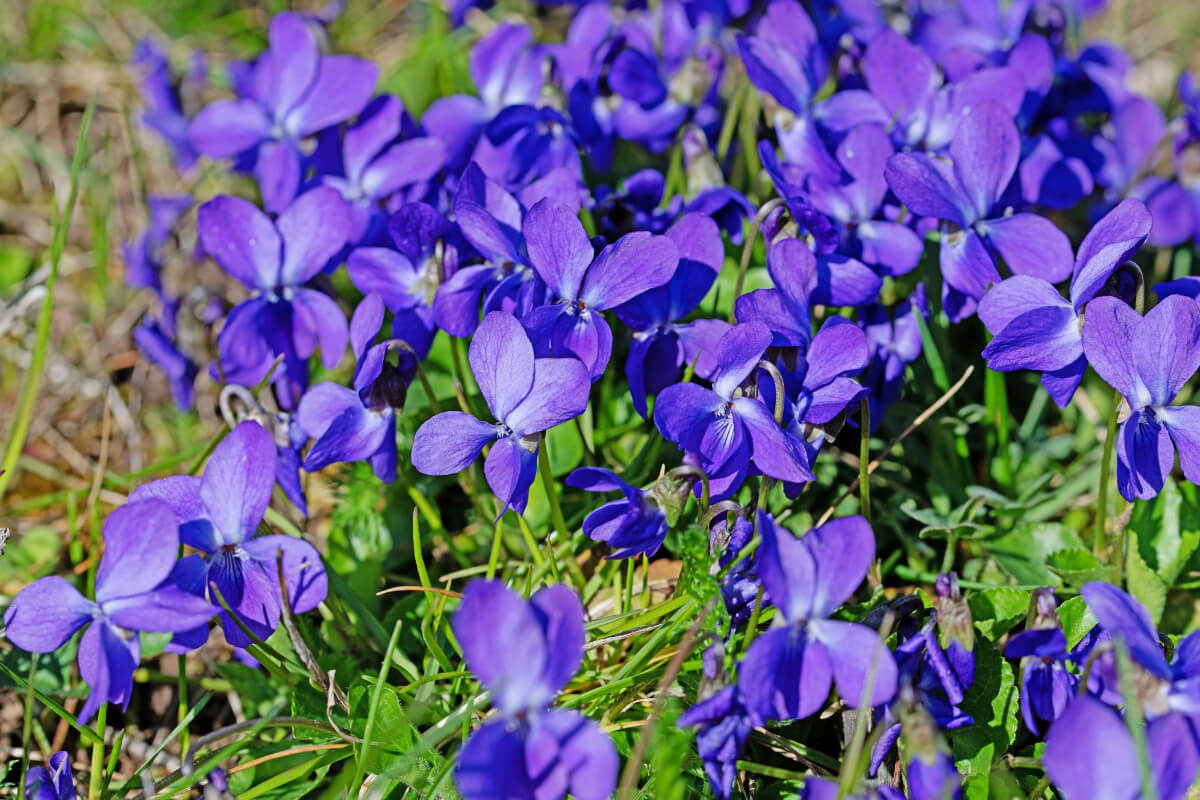
| Location | Description | Benefits/Uses |
|---|---|---|
| North America | Small, edible flowers in meadows and lawns. | Rich in vitamins C and A |
Wild violets or common blue violets are small, edible flowers that grow in North America’s meadows and lawns. Violets have heart-shaped green leaves in blue, purple, white, or yellow.
Both the wild violet flowers and the leaves are safe to eat. The flowers have a slightly sweet taste, a silky texture, and a mild wintergreen flavor. A large quantity of flowers can even be used to make wild violet jelly.
Edible violets are rich in vitamins C and A and other vitamins and minerals. Violet leaves are also available as a supplement.
2. Coneflowers (Echinacea species)
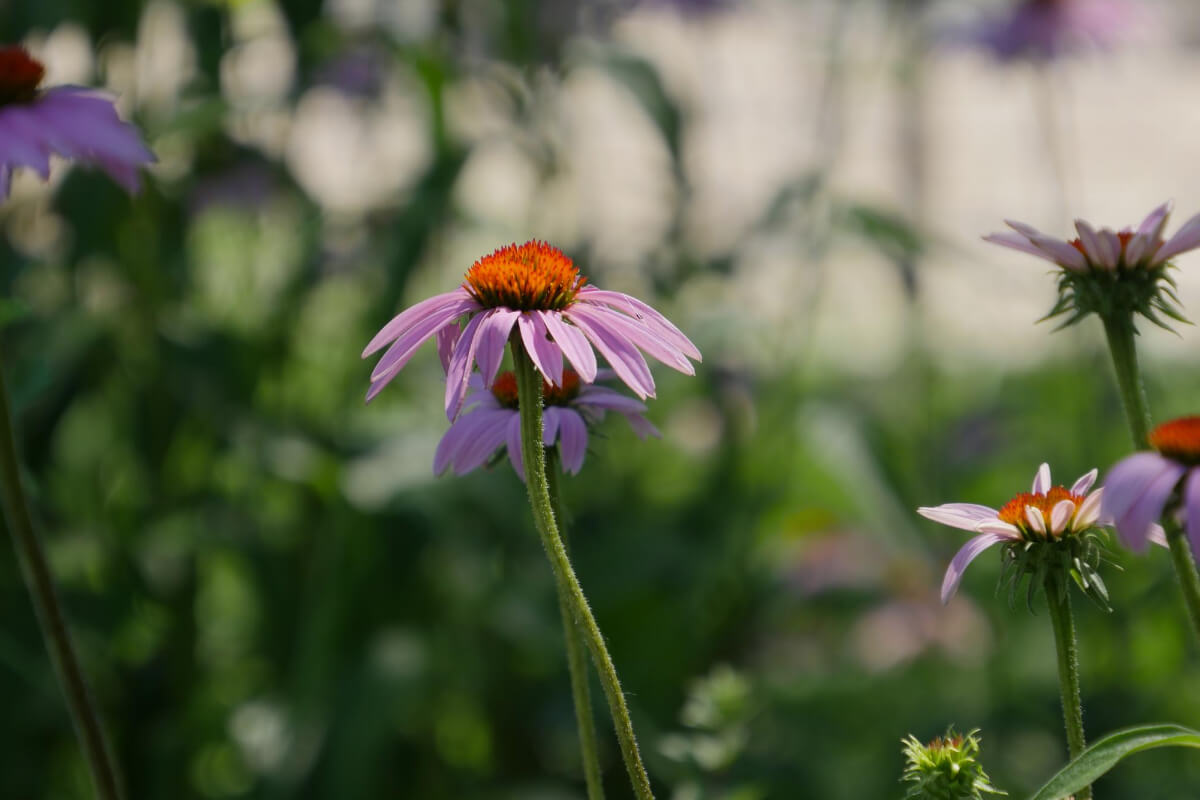
| Location | Description | Benefits/Uses |
|---|---|---|
| Eastern and Central US | Coneflowers, often confused with daisies, are found in the eastern and central US. | Pleasing to the eye and nose with a sweet fragrance, they offer a peppery flavor and are rich in flavonoids and other beneficial compounds. |
Coneflowers are often confused with daisies because they look alike and are in the same family. They are not only pleasing to the eye and nose, with their sweet fragrance, but also to the taste buds, offering a peppery flavor. These flowers are more than just pretty — they are packed with flavonoids and other benefits that can help keep you healthy.
Here are some quick facts about coneflowers and how you can enjoy them:
- Where to Find Them – You can spot coneflowers in the open areas of woods and fields in the eastern and central U.S.
- Growing Them – They are super easy to grow and don’t need much attention, just lots of sunlight. The most common type in North America has purple flowers and blooms from midsummer to the first frost.
- Eating Them – The petals are great for adding color to your food and making a strong herbal tea. They have a zesty flavor. While the leaves and roots are also edible, they are mostly used for their health benefits.
Adding coneflowers to your diet can help boost your immune system and fight off colds and flu, thanks to all those flavonoids. Whether you’re enjoying their beauty in your garden or their taste in your tea, these flowers are a delightful and useful addition to your life.
3. Wood Sorrel Flowers (Oxalis species)
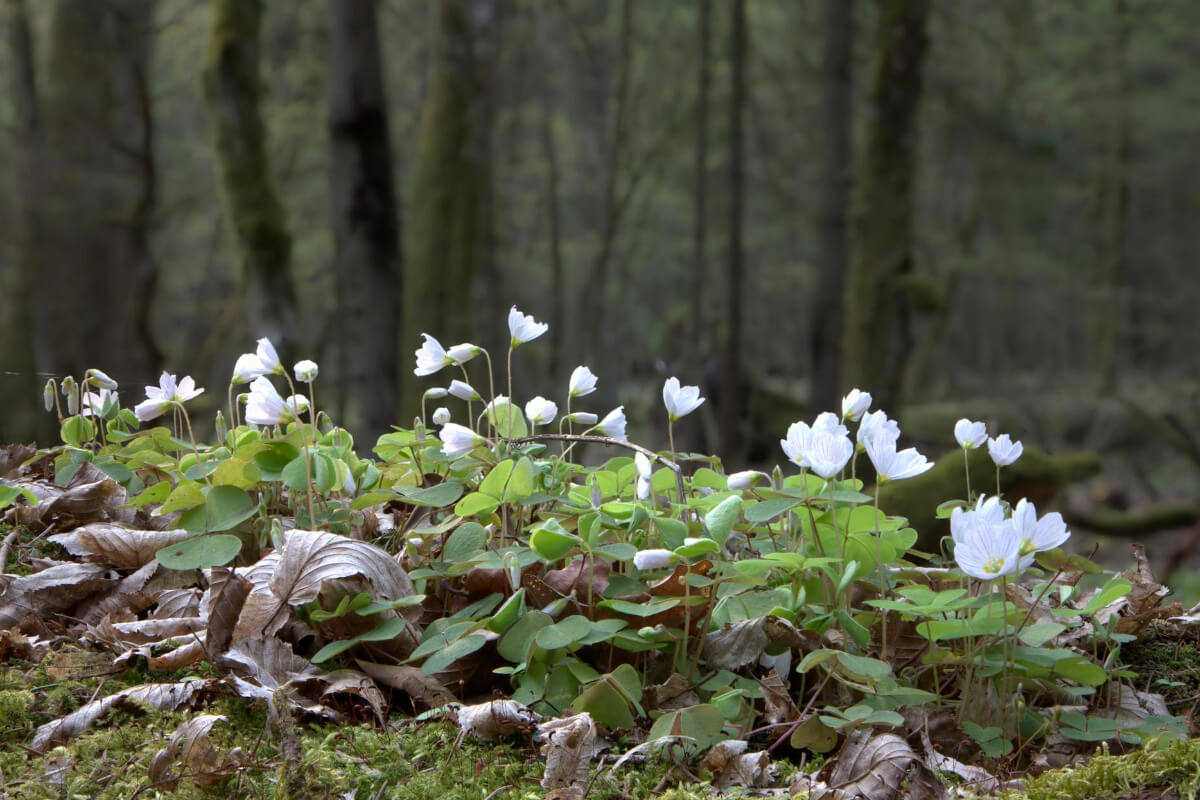
| Location | Description | Benefits/Uses |
|---|---|---|
| Worldwide | Edible plant with citrus taste — recognized by white and yellow flowers and clover-like leaves | Adds refreshing lemony flavor to dishes, rich in electrolytes for quick snacks, moderation advised due to oxalic acid |
Wood sorrel, with its edible flowers, stands out as a tasty treat among the varieties of this plant family. Unlike its relatives, wild sheep sorrel and common sorrel, wood sorrel offers a unique citrus taste that’s perfect for culinary use. This plant, often recognized by its white and yellow flowers and clover-like leaves, brings a refreshing, lemony flavor to dishes.
The sour taste of wood sorrel, attributed to oxalic acid, makes it a great addition to salads, soups, and even desserts, adding a fresh and tangy note. Its high water content and abundance of electrolytes also make it a fantastic choice for a quick snack on the go, especially for hikers.
This acid, also found in various vegetables like spinach and broccoli, not only improves the flavor of wood sorrel but also contributes to its thirst-quenching properties.
It’s important to note that despite its delicious taste and culinary versatility, wood sorrel used in moderate amounts is the best way to enjoy it. This precaution is due to the same oxalic acid that gives it its unique flavor, which in large quantities can be harmful.
4. Daisies (Bellis perennis)
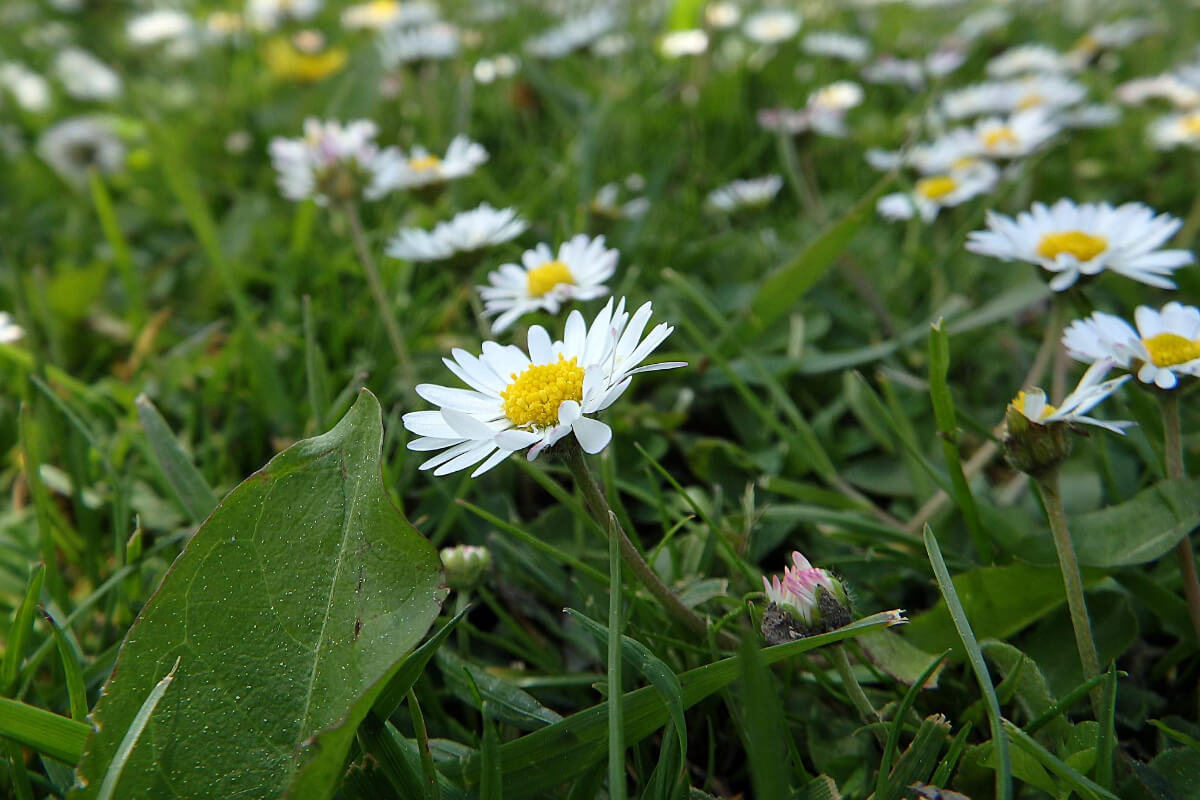
| Location | Description | Benefits/Uses |
|---|---|---|
| Europe, Americas | Found in open spots like fields, used in agriculture and as bedding plants for their pretty white petals | Used as decorations on food, aid digestion, leaves eaten raw or cooked for their tangy taste and health benefits |
Daisies, also known as common or English daisies, come from Europe but now grow in many places with mild weather, like the Americas. You can find them a lot in open spots, especially fields. People plant them in agriculture for looks and use them as bedding plants because of their pretty white petals.
Daisy flowers can be eaten, but they might taste a bit bitter. They work great as decorations on top of salads and cupcakes, adding a nice touch to your food. You can also put them in soups or use them to make tea.
Eating daisies is good for your stomach because, even though they’re bitter, that bitterness helps with digestion. And you can eat the leaves, too, either raw or cooked. They have a tangy taste and some special properties that are good for you.
5. Chicory Flowers (Cichorium intybus)
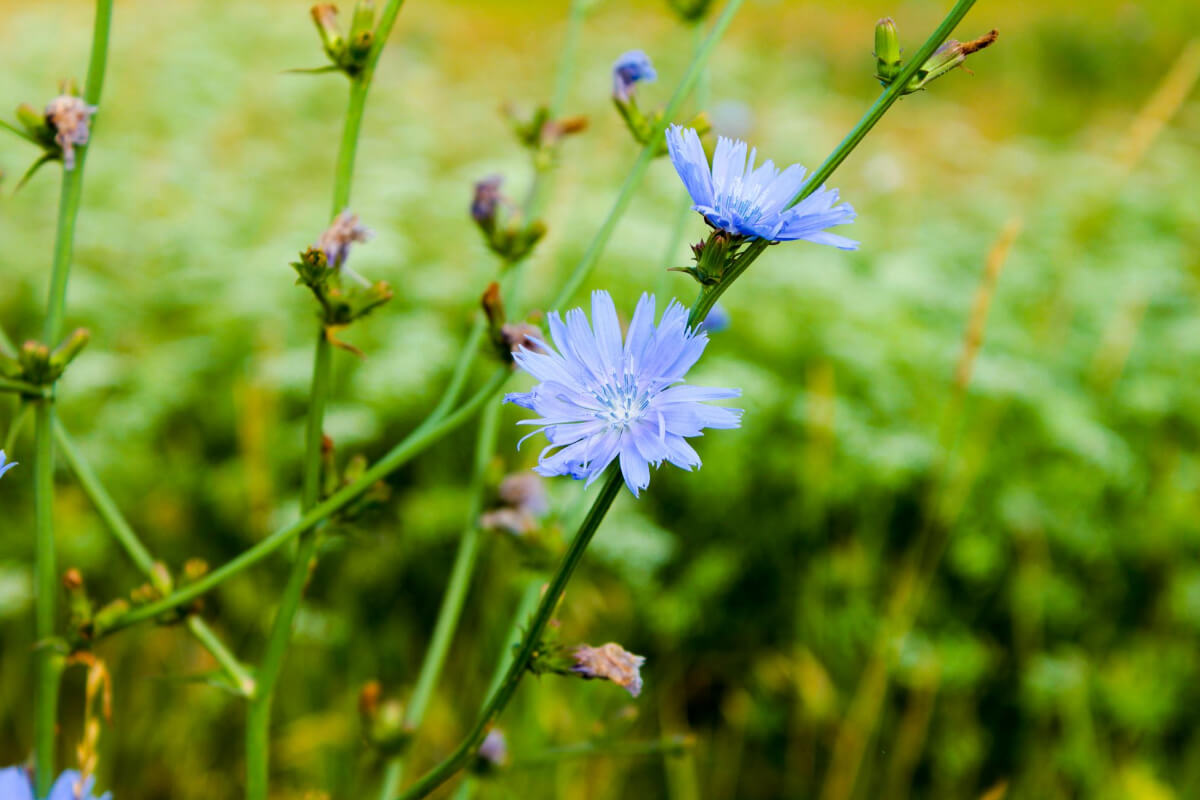
| Location | Description | Benefits/Uses |
|---|---|---|
| Europe, North America | Tall weed growing in dry spots and by roads — recognized by bright blue petals. | All parts are safe to eat, rich in the probiotic inulin |
Chicory, a tall weed from Europe now found widely in North America, grows in dry spots and by roads. You can spot it easily by its bright blue petals.
Even though its leaves look like dandelion leaves when not flowering, all parts of chicory are safe to eat.
Chicory Eating Tips:
- Flowers – Tasty raw in salads or with strong flavors like aged cheeses.
- Leaves – Boil them, especially later in the year, to get rid of the bitter taste. Change the water a few times.
- Roots – Dried and ground, they’re used in New Orleans coffee. They’re also a caffeine-free, low-acid coffee substitute on their own. Chicory roots are rich in inulin, a probiotic, plus minerals and vitamins.
6. Dandelions (Taraxacum officinale)
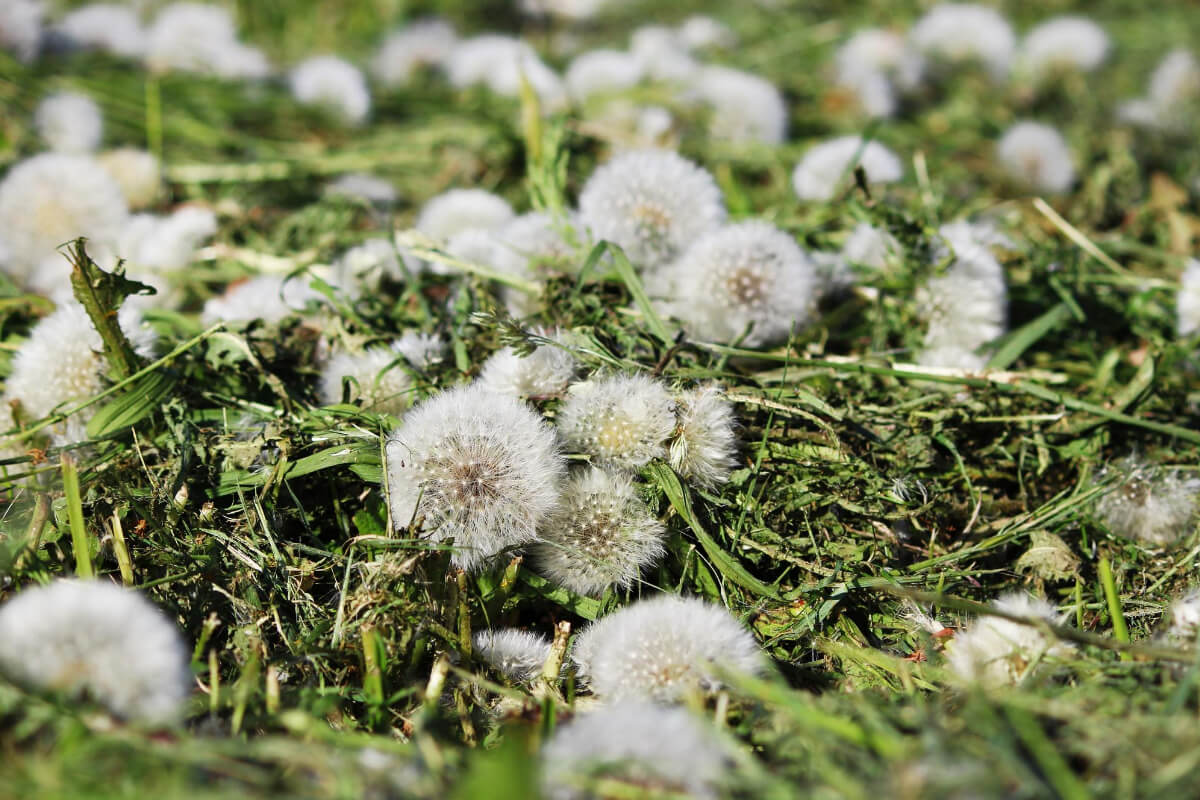
| Location | Description | Benefits/Uses |
|---|---|---|
| Sunny areas | Edible plant with nutritious parts, flowers rich in antioxidants | Harvest tender leaves after winter, unopened flower buds taste like capers, bright yellow flowers are sweet, and roots make a good coffee substitute. |
Dandelions seem everywhere in the spring, but most people don’t know their many uses. All parts of this plant are edible and very nutritious. The dandelion flowers are rich in antioxidants, while the leaves contain minerals and vitamins A, C, and K. Dandelions grow mostly in sunny areas.
If your dandelion harvest timing is right, you can take advantage of the entire plant. The first leaves to grow after winter are the most tender and have the least bitter flavor. The unopened flower buds taste like capers and can be preserved in extra virgin olive oil. The bright yellow flowers are very sweet.
They are amazing raw in salads and are ingredients in many recipes, such as jellies, wines, syrups, and candies. The roots, like chicory’s, make a good coffee substitute.
7. Coral Honeysuckle Flowers (Lonicera sempervirens)
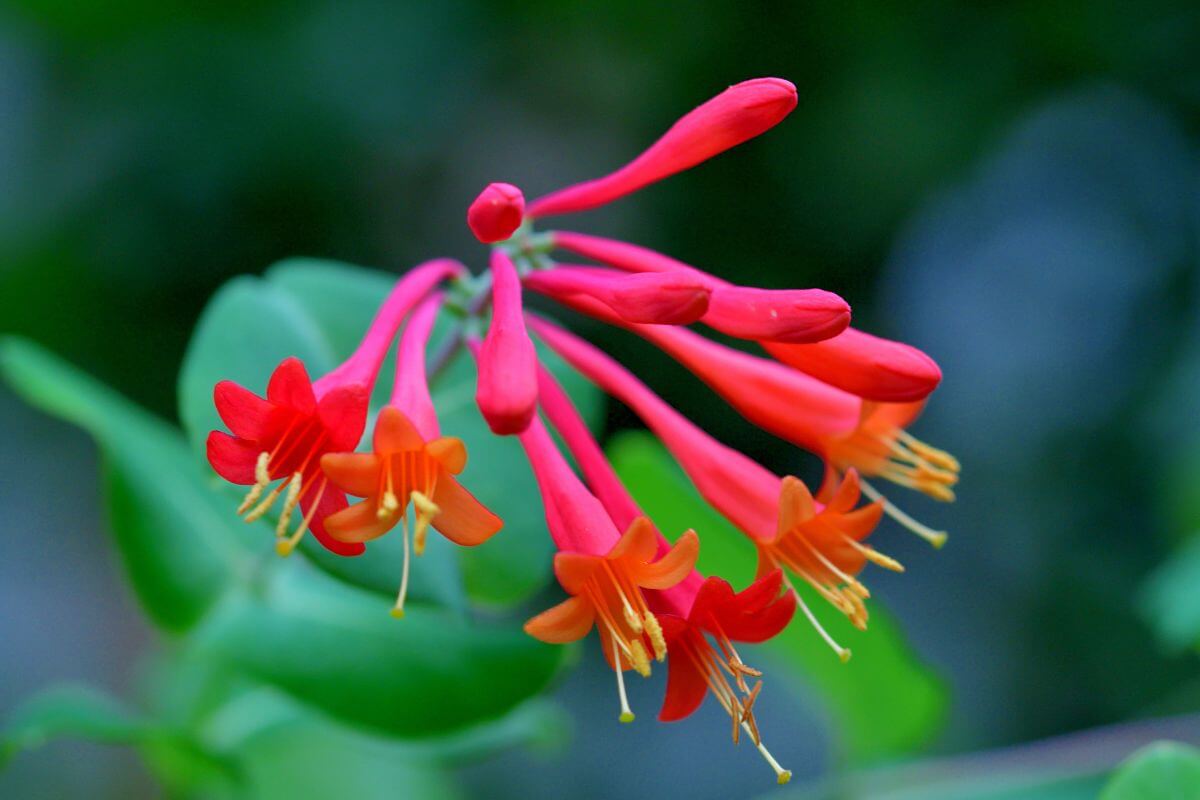
| Location | Description | Benefits/Uses |
|---|---|---|
| Eastern United States | Coral honeysuckle, a native vine, is less invasive than other honeysuckles, growing easily without overtaking gardens. | Used by Native Americans as medicine, sweet-tasting flowers that can be used in salads |
Most honeysuckle species are invasive in the United States, but the coral honeysuckle is one of the exceptions. Native to the eastern United States, this plant is a vine, like its Asian cousins.
It grows easily both in the wild and planted, and it’s not as fast-growing as other honeysuckles, which will completely take over your garden. If you choose to harvest this plant, though, exercise caution. Never eat the berries, as they can cause nausea and vomiting.
Coral honeysuckle leaves were used as medicine by Native Americans, and many people have reported eating their flowers without problems. The beautiful red, tubular flowers taste sweetest when harvested in the spring and are excellent in salads.
Modern science hasn’t studied coral honeysuckle much, but this edible plant has medicinal properties.
8. Japanese Honeysuckle Flowers (Lonicera japonica)
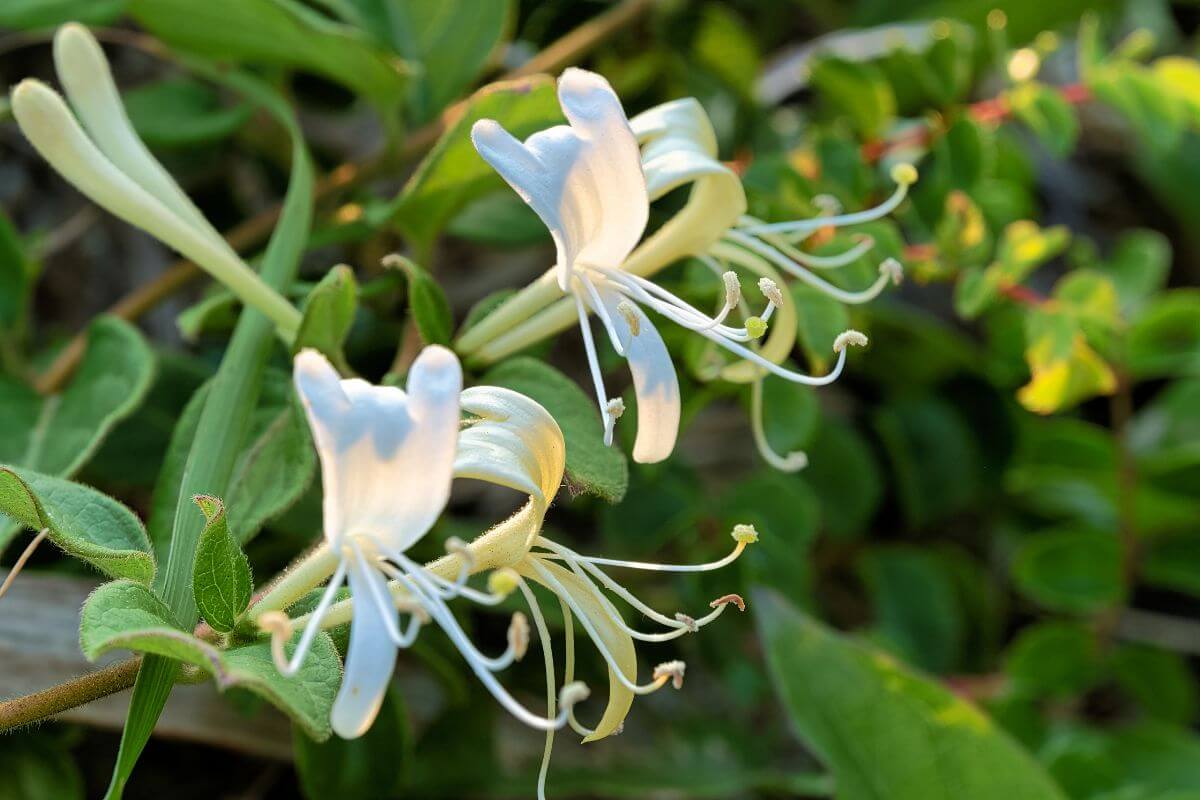
| Location | Description | Benefits/Uses |
|---|---|---|
| North America | Invasive species from Asia, widespread in the wild, are detrimental to indigenous plants. | Known for sweet nectar in flowers, can be used in teas, puddings, or soups, caution is advised with leaves, as they may be toxic. |
Japanese honeysuckle is one of the invasive species from Asia that can now be commonly found in the wild in most of the country and North America. It’s a very vigorous plant that shouldn’t be planted, as it’s difficult to control and is detrimental to indigenous species.
If you find it in the wild, there’s nothing wrong with picking the beautiful yellow or white flowers. Japanese honeysuckle grows best in shaded areas.
The Japanese Honeysuckle flowers are well-known because of their sweet nectar, which you can suck directly from the bottom for a quick trail snack. They can also be cooked for teas, puddings, or soups. The leaves of this plant are commonly eaten in some countries, but they might be toxic.
Be careful of similar species, as many plants of the same genus are poisonous in various degrees.
9. Wild Brassica Flowers (Brassicaceae species)
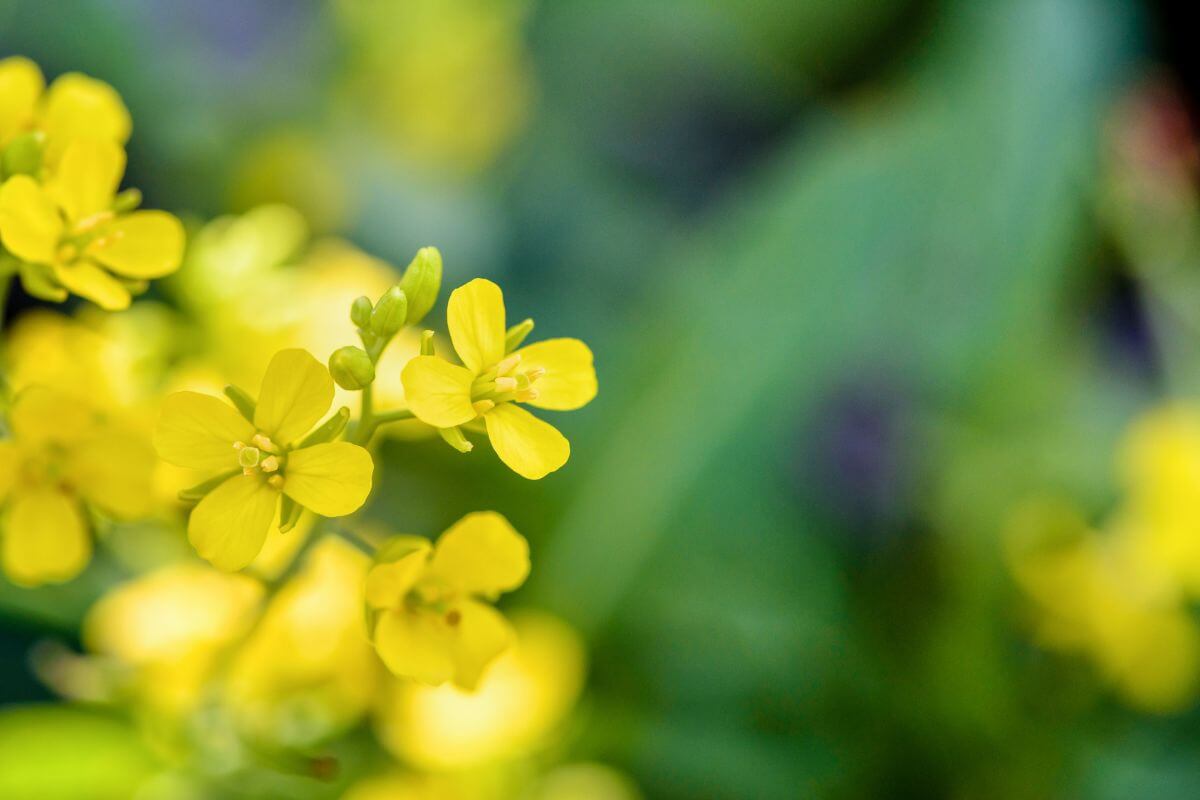
| Location | Description | Benefits/Uses |
|---|---|---|
| North America | Descendants of cultivated European varieties like broccoli and kale, also known as mustard flowers for their sweet taste. | Ideal for sandwiches, salads, and savory dishes. The seeds can be used as seasoning or processed to make mustard. |
The many species of wild brassicas found throughout North America are descendants of the more famous cultivated varieties imported from Europe. These include broccoli, kale, and cabbages.
Wild brassicas grow in open fields and along roads and are easily recognizable once you know them. The yellow flowers bloom in late winter and early spring, which is the best time to harvest them. Brassica flowers can also be grown easily in your garden whenever you wish.
Wild brassicas are also called mustard flowers, as their sweet taste resembles true mustard. They are perfect for sandwiches and salads or to add flavor to any savory dish. If you have enough patience, the seeds can be used as a seasoning or processed to make mustard.
The leaves should also be picked in early spring, as they can be bitter, especially if they are not very young. It’s best to eat them boiled to make them more palatable. Brassicas are packed with vitamins A, B, and C.
10. Black Locust Flowers (Robinia pseudoacacia)
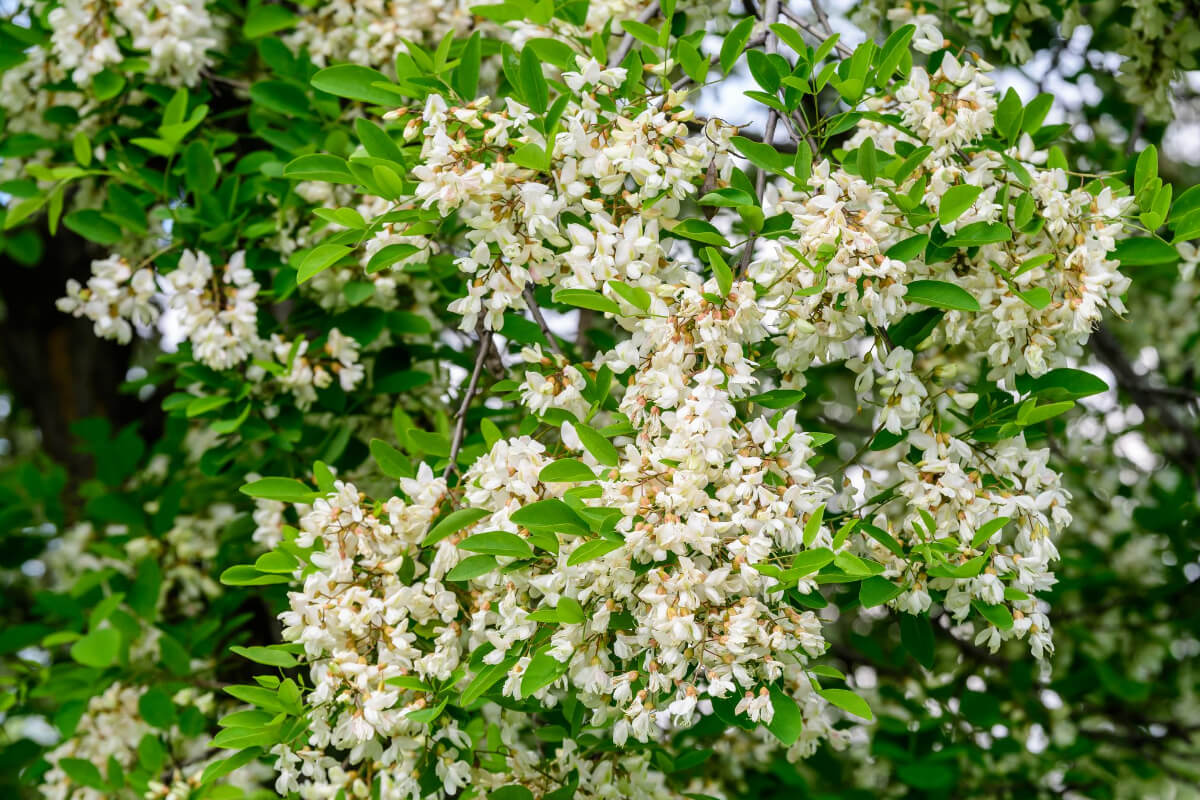
| Location | Description | Benefits/Uses |
|---|---|---|
| Southeastern United States | Belongs to the legume family, fast-growing trees requiring full sun and no competitors. | Edible flowers with a sweet taste, ideal for raw consumption or in stir-fries, salads, and omelets. They are reported to have antioxidant and anti-inflammatory properties. |
Like beans and lentils, the black locust tree belongs to the legume family. It’s mostly found in the southeastern United States, but some individuals grow in other parts of the country under the right conditions — full sun and no competitors. They are fast-growing trees that don’t live very long.
Despite the name, the flowers are white, not black. Depending on the climate, they can bloom as early as mid-April or until early June. Once they appear, they last for about a week.
Although the bark of the black locust is covered in prickly thorns, the flowers, which form large clusters hanging down the branches, can be easily picked.
Black Locusts are some of the best flowers to eat raw — you’ll be amazed at how sweet they taste. You can make stir-fries, salads, and omelets if you take some home. These flowers are reported to have antioxidant and anti-inflammatory properties.
11. Eastern Redbud Flowers (Cercis canadensis)
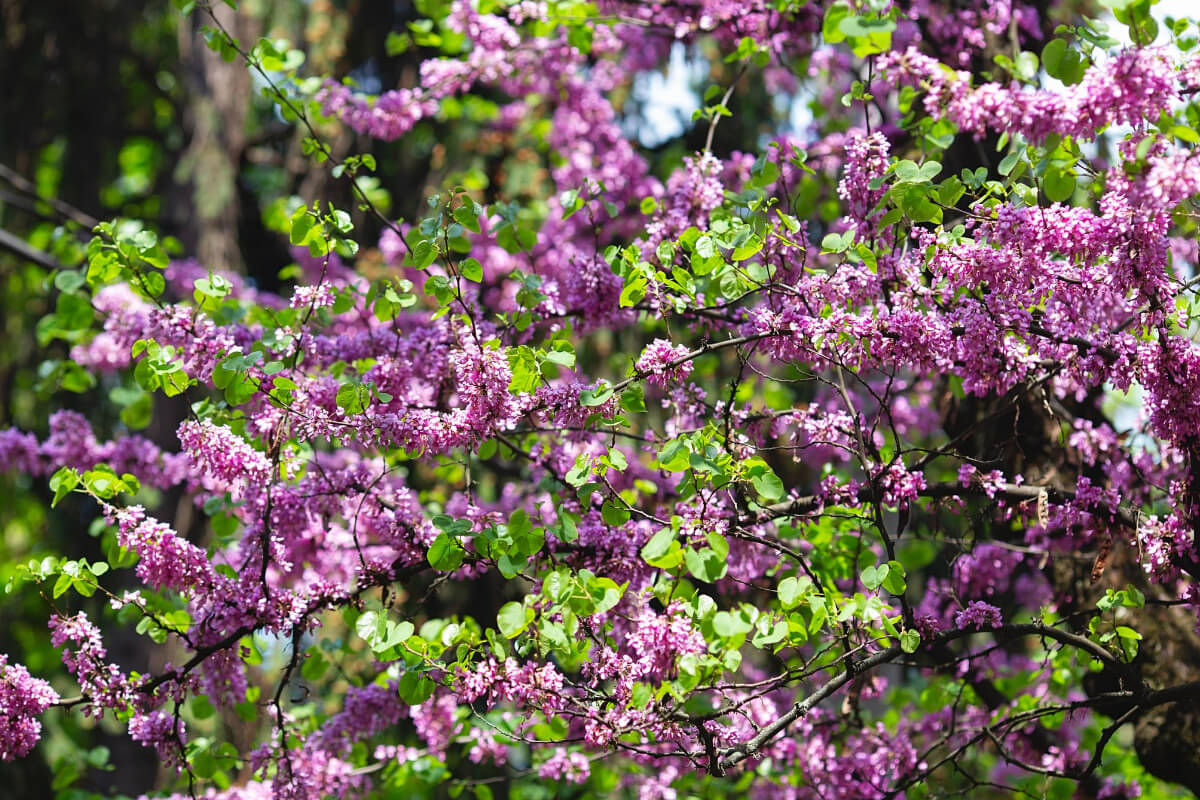
| Location | Description | Benefits/Uses |
|---|---|---|
| Eastern United States | Native trees commonly found in hedgerows and mixed forests, are part of the legume family. | Tasty flowers with a sweet flavor resembling peas and a hint of lemon, tender if picked early, best when fully opened for sweetness. |
Redbud trees are native to the eastern U.S. and are frequently found in hedgerows and mixed forests. Like the black locust tree, they are part of the legume family.
They are commonly planted in parks and gardens, where they are much appreciated for their bright purple-pink flowers. These flowers are some of the earliest to bloom in the spring, and they grow before the leaves do, so the effect is even more striking.
Redbud flowers are very tasty. Their sweet flavor resembles peas, with a hint of lemon. They are very tender if picked early, but wait until they’ve opened — otherwise, they won’t be as sweet.
These flowers can be eaten fresh or fried and are rich in anthocyanins, which act as antioxidants. The twigs are also edible and are sometimes used as meat seasoning. Native Americans used to eat the roasted seeds, too.
12. Chinese Wisteria Flowers (Wisteria sinensis)
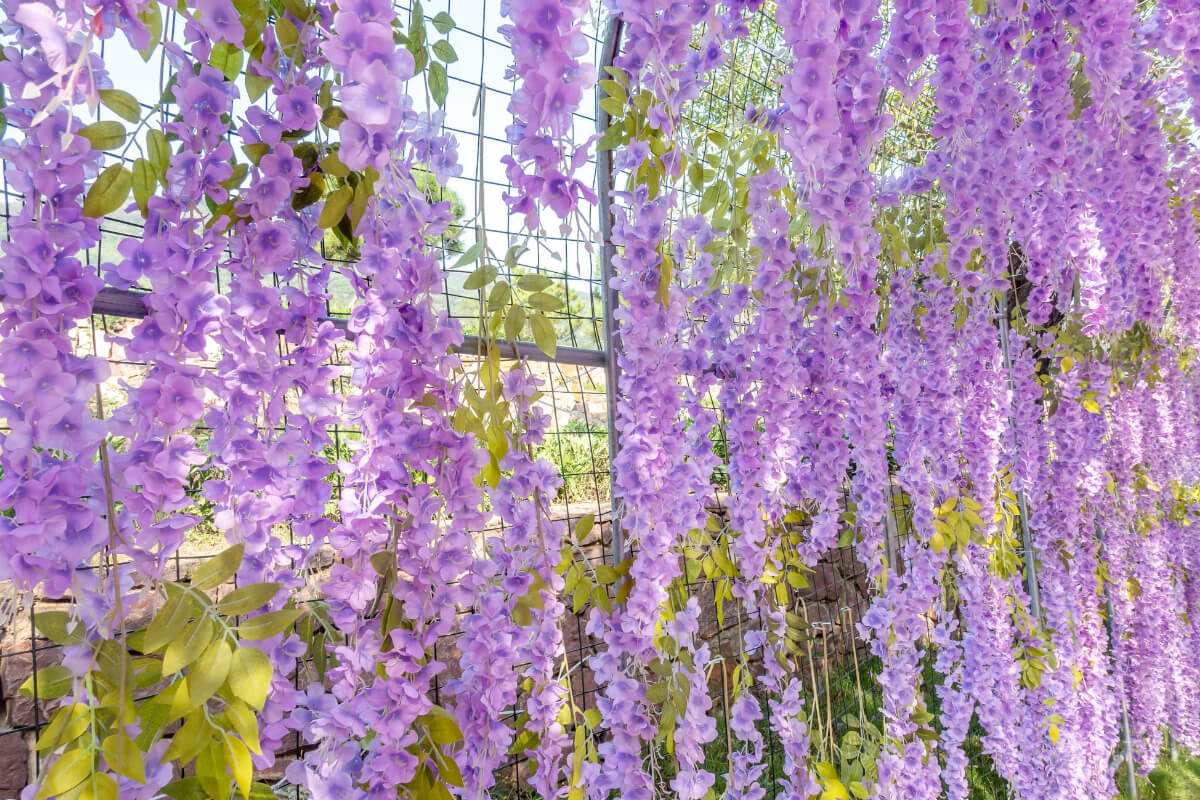
| Location | Description | Benefits/Uses |
|---|---|---|
| Eastern United States | Native to Asia, invasive in some areas, are part of the legume family and often climb on walls and pergolas. | Sweet-smelling flowers in large clusters, sweet taste with pea-like flavor, are edible raw or cooked but stems must be removed due to toxicity. |
Chinese wisteria is a vining plant native to Asia. It is part of the legume family and is very common in the eastern United States, where it is invasive in some areas. It normally climbs on supports such as walls and pergolas but can also be freestanding.
Wisteria has become the most popular ornamental vine worldwide thanks to its abundance of beautiful lavender flowers. However, other types of wisteria, both non-native and native, have less fragrant flowers and are not as suitable for culinary purposes.
The sweet-smelling wisteria forms huge flower clusters that hang down from the branches. Its taste is quite sweet and a bit pea-like. The flowers can be eaten raw or cooked, but it is important to remove the stems because they are toxic.
All parts of the plant are poisonous except the flowers, as they contain a toxic glycoside. Even flowers are best eaten in moderation only if you’re sure what you eat.
13. Orange Daylilies (Hemerocallis fulva)
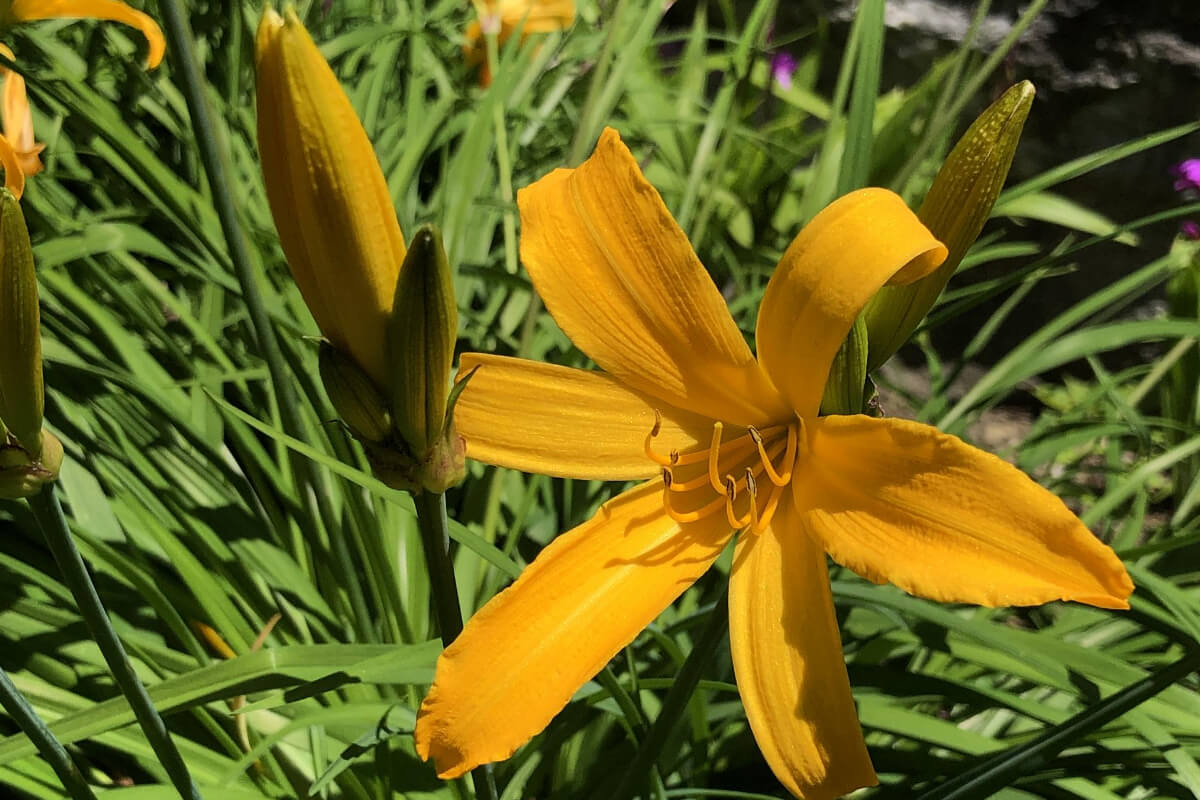
| Location | Description | Benefits/Uses |
|---|---|---|
| United States | Wild orange daylilies are commonly found in fields and roadsides, adorned with bright orange flowers. | Popular decorative plants with various species, but caution advised regarding edibility, stick to original wild variety for consumption. |
You can find orange daylilies growing wild in the U.S., with their bright orange flowers all over fields and by the sides of roads.
People also like to use daylilies as decorations because they look pretty. There are lots of different kinds, but we’re not sure if all of them are safe to eat. It’s best to stick to the original wild kind if you want to eat them.
In China, daylilies are a hit in cooking and are used in lots of dishes. Some people think they taste better when they’re cooked, but you can also eat them raw in salads for a lettuce-like taste. The flower buds are good for frying or just eating as a snack. And you can eat the young tubers (kind of like roots) and leaves, too, either raw or cooked.
Daylilies have great things in store for you, like carotenoids in the flowers and lots of vitamin A, vitamin C, and proteins in the buds. But be careful because the flowers can make you go to the bathroom a lot, and the buds can act like a diuretic. That means you should only eat a little bit of the shoots at first and try just one flower to make sure you’re not allergic.
14. Kudzu Flowers (Pueraria species)
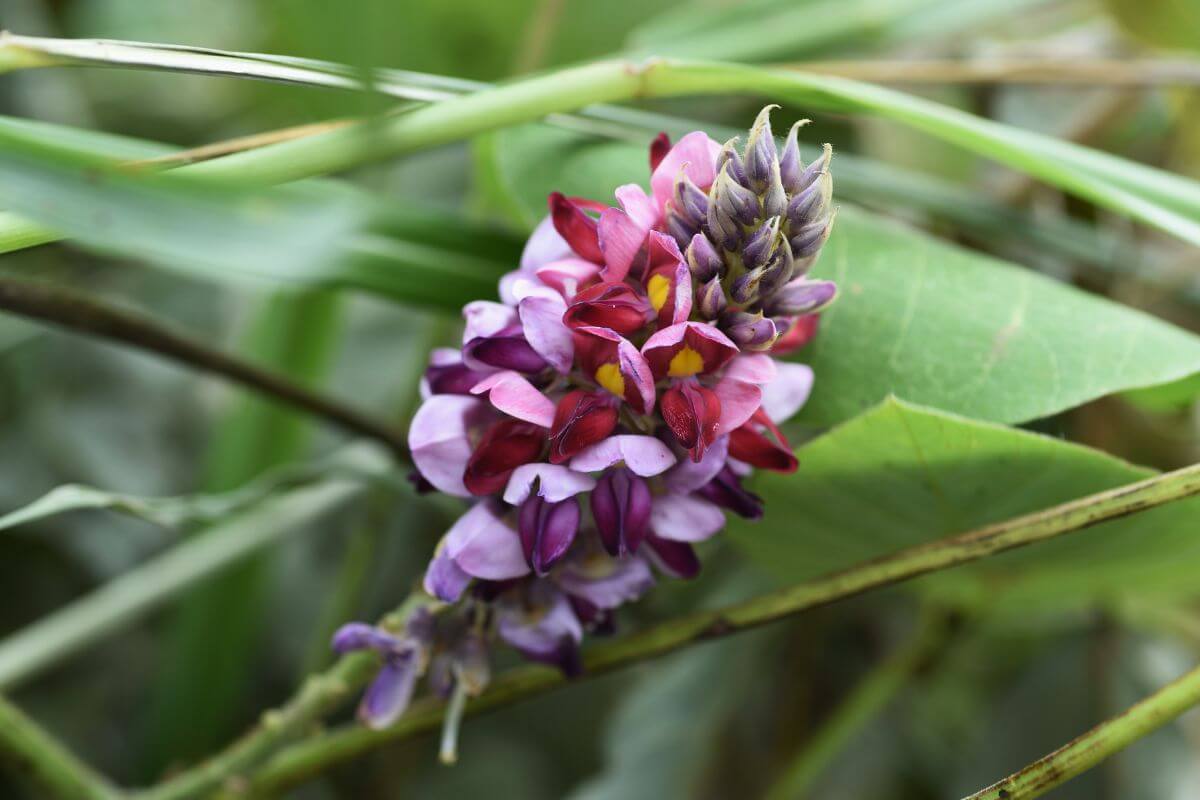
| Location | Description | Benefits/Uses |
|---|---|---|
| United States | Native to Asia and naturalized in the U.S., is a fast-growing vine known for suffocating plants, especially in the southeastern forests | Flowers are used to make jellies with grape-like flavor, also edible raw in salads, roots have various uses. |
Kudzu is a noxious weed native to Asia that has naturalized in the United States. It’s a fast-growing vine that can suffocate the plants it grows on. Kudzu covers the edges of forests in the southeast and can grow over entire trees.
Kudzu was imported to America to control erosion and as animal feed, but it has become widespread in almost all of the states. It does particularly well in the South, where its advance is seemingly unstoppable.
Kudzu flowers are traditionally used to make jellies, which taste similar to grape jelly. They can also be eaten raw as an ingredient in salads. The plant’s roots are the most interesting part.
They are rich in starch and popularly used as culinary starch in many Asian recipes. You can make flour from them to substitute cornstarch or use them to make tea. All parts of the plant are rich in antioxidants.
15. Turk’s Cap Flowers (Malvaviscus arboreus)
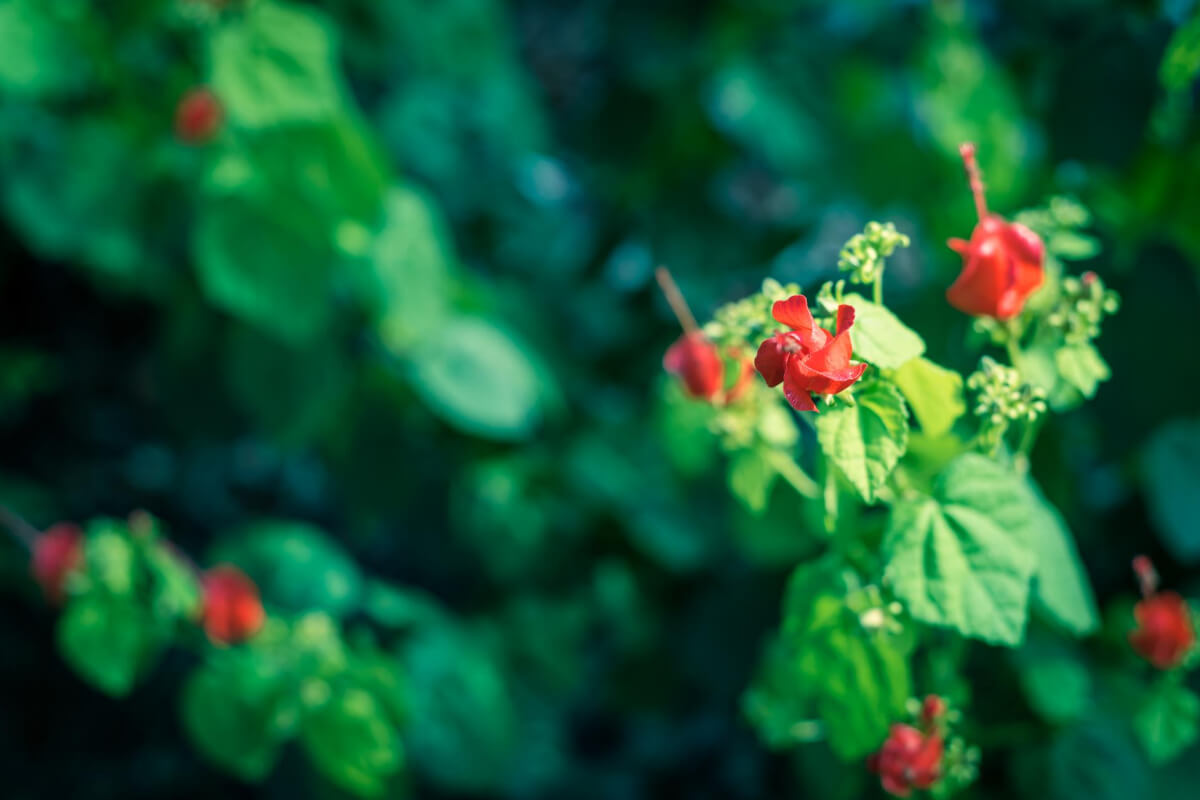
| Location | Description | Benefits/Uses |
|---|---|---|
| Gulf States, Mexico, Central America | Known scientifically as Turk’s caps, part of the hibiscus/mallow family | Leaves rich in antioxidants and minerals, suitable for cooking like spinach, berries contain high vitamin C content. |
Turk’s caps are best known by their scientific name, as many other unrelated plants have the same common one. It is part of the hibiscus/mallow family. It is native to the Gulf states, Mexico, and Central America.
This plant can also be cultivated, which is often done in bird gardens, as it’s a favorite food for hummingbirds. When fully grown, these shrubs resemble small trees and can be found at the edges of woods or covering forest floors. They prefer partial shade, but they adapt to various conditions when cultivated.
Turk’s caps grow stunning red flowers that taste as good as they look. You can eat them raw for a sweet snack, cook them, or dry them for tea. The berries taste like apples and can be eaten raw, but some prefer them in jellies or jams.
The leaves are an excellent source of antioxidants and minerals and can be cooked like spinach. The berries are a great source of vitamin C.
16. Wild Rose (Rosa acicularis)
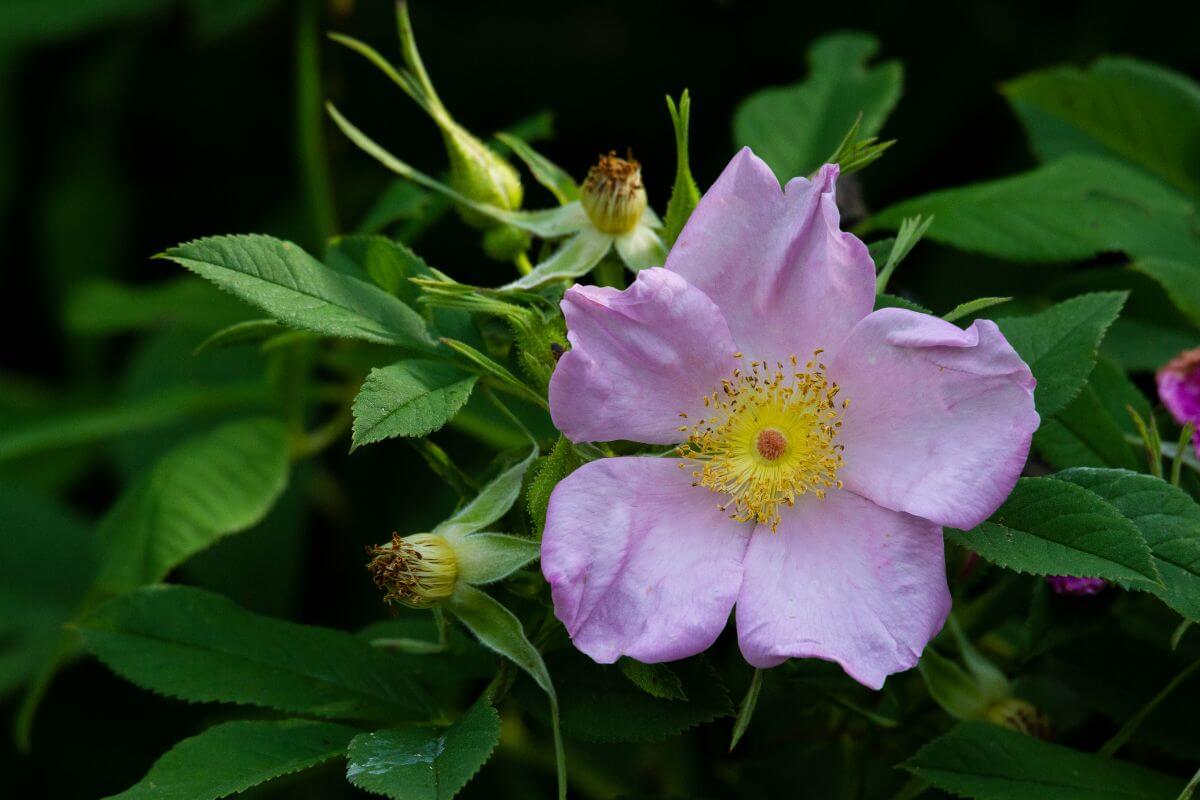
| Location | Description | Benefits/Uses |
|---|---|---|
| Europe, Northern Asia, North America | Edible petals and rose hips offer nutritional benefits, with flavors varying by variety and growing conditions. | Edible petals and rose hips offer nutritional benefits, with flavor varying by variety and growing conditions. |
Roses are more than just beautiful — they’re also edible and full of goodness. All true roses (genus Rosa) can be eaten, including their petals and rose hips. The taste of these parts varies depending on the rose’s type, color, and how it’s grown.
Here’s how you can enjoy roses from your garden or the wild:
- Harvest the Buds and Flowers of Wild Roses – You can dry them to make tea. The flavor of the tea can be tart, sweet, or spicy, with darker petals giving a more intense taste. Just make sure to remove any bitter white parts.
- Grow Wild Roses in Your Garden – Their pink flowers, with a strong rose scent, are perfect for eating fresh in salads, or as a sweet treat when candied. You can also use them to make rosewater.
Both wild and cultivated roses offer the same benefits. Rose hips, the fruit of the rose bush, are especially rich in vitamin C and antioxidants. They are great for your health, whether you pick them from wild bushes or your garden.
17. Pineapple Weed (Matricaria matricarioides)
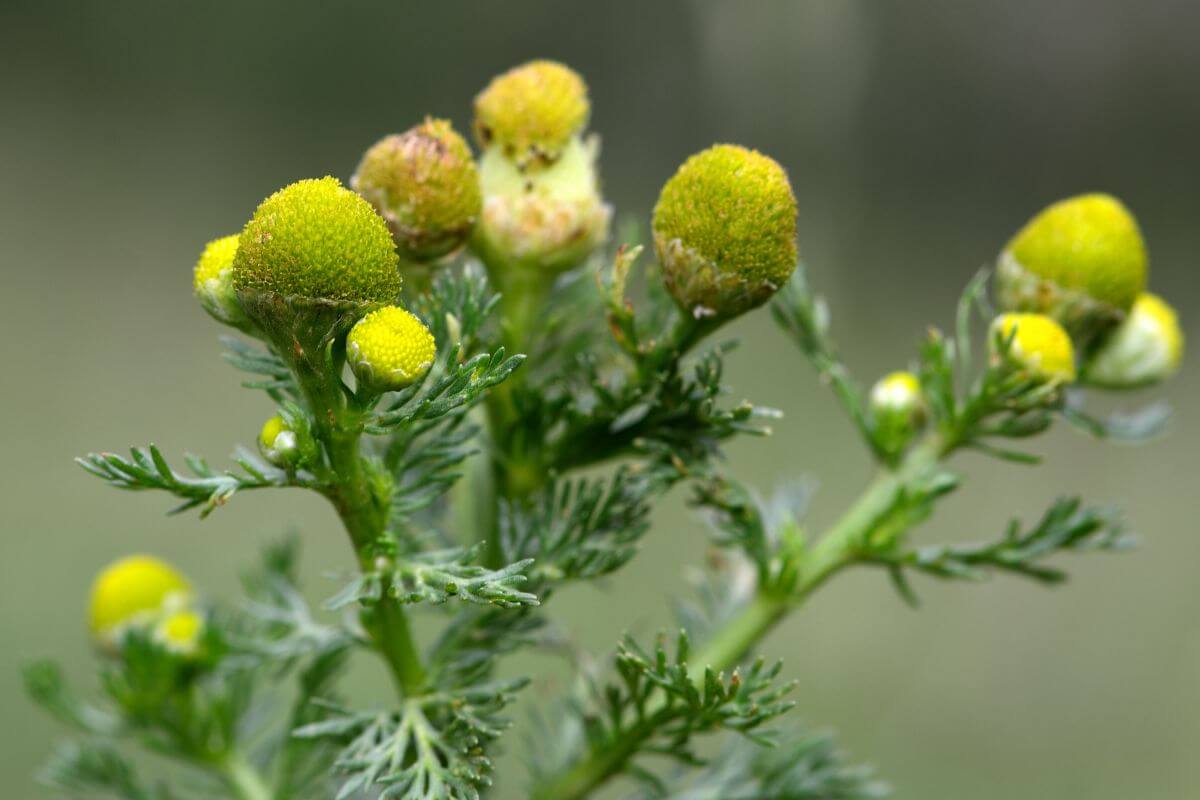
| Location | Description | Benefits/Uses |
|---|---|---|
| Northeast Asia, Northwestern North America | Pineapple weed thrives in compacted soil, often overlooked due to its small size. | Features pineapple-like taste and aroma, flowers edible raw, versatile for culinary use. |
Pineapple weed is a plant that grows in compacted soil, like gravel driveways and parking lots. It is commonly found in parts of northeast Asia and northwestern North America. Despite being abundant, it is often overlooked due to its small size and shy nature.
Pineapple weed has a taste and aroma similar to pineapple. The small cone-shaped flowers can be eaten raw in salads, relishes, and quick herb salads for fish. You can use fresh or dried pineapple weed to infuse alcohol and syrups. It’s also great for making iced tea.
- Read more about the Different Edible Weeds
It is similar to German chamomile and is used as a substitute in herbal remedies. It has sedative properties that may help with anxiety and insomnia, as well as antispasmodic and anti-inflammatory properties, which can be useful for menstrual cramps and stomach and intestinal pains.
Edible Wild Flowers Final Thoughts
There are so many different types of wildflowers out there that we could spend weeks exploring them all. No matter the flowers you find in the woods, be sure that you correctly identify the plant before consuming it.
If you feel adventurous or hungry, only eat the plant raw in small amounts first. If you get sick after eating it, you’ll know not to eat it anymore.
Incorporating wild edible flowers into your diet can be a delightful adventure, but safety and sustainability should always come first. Enjoy the exploration and discovery of these natural treasures!
Discover more about other edible plants in these articles:

